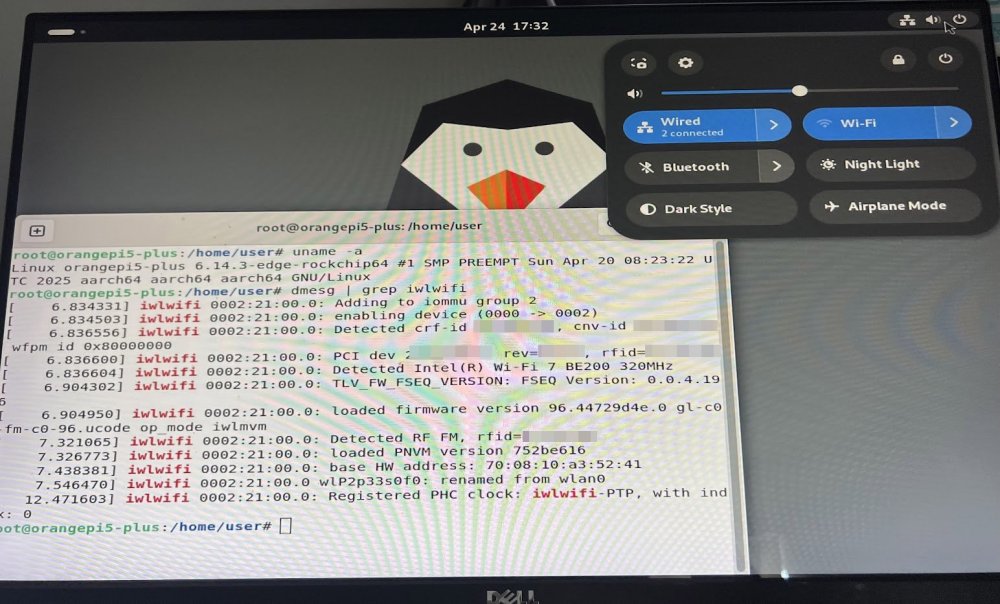All Activity
- Past hour
-
I have the latest revision of the armsom sige 5. This board has an updated Wi-Fi chip set. It was changed from RTL wireless to a Broadcom chip connecting to the rk3576 with SDIO 3.0. I grabbed the latest Armbian image and it appears in the device tree It is still referencing the RTL Wi-Fi device. has anyone encountered this and found a solution? Or has gotten Wi-Fi working? I’ve attached the device tree. sige5.dts
-
I have got my T95Z Plus with S912 booting 6.12.24-current-meson64 just fine now. Getting Jellyfin up and running with all my old DVDs and CDs. Seems very capable. When do I push the OS into the eMMC? Is there a downside? Are there only so many times I can do this safely? If I chose to try the Debian builds - don't I just boot from a SD card and try it out? If I like that one better - then don't I just repeat the process and push that onto the eMMC? I believe I have the Android Source - or more precisely - I have a rom called SuperCelleron that I installed almost 10 years ago... That still boots when I don't have an SD card in. Also - visual inspection of this board proves I have an eMMC. I have another box that is identical outside. But on the inside it clearly has a NAND chip. I am sure this is a silly question - but just thought I'd ask. Thanks all.
-
Here's the steps to create a secure boot image git clone https://github.com/NickAlilovic/build.git --branch v20250306 cd build pico patch/u-boot/u-boot-h616/153-add-tanix_tx6s_axp313_defconfig.patch You need to add this line to the bottom. "+CONFIG_SPL_IMAGE_TYPE_SUNXI_TOC0=y" and change "@@ -0,0 +1,37 @@" to @@ -0,0 +1,38 @@. diff --speed-large-files --no-dereference --minimal -Naur u-boot-sunxi-647b392bf20614006917d5fcd3390347a668eee5/configs/tanix_tx6s_axp313_defconfig u-boot-sunxi-647b392bf20614006917d5fcd3390347a668eee5/configs/tanix_tx6s_axp313_defconfig --- u-boot-sunxi-647b392bf20614006917d5fcd3390347a668eee5/configs/tanix_tx6s_axp313_defconfig 1970-01-01 01:00:00.000000000 +0100 +++ u-boot-sunxi-647b392bf20614006917d5fcd3390347a668eee5/configs/tanix_tx6s_axp313_defconfig 2023-04-08 11:53:13.408413187 +0200 @@ -0,0 +1,38 @@ +CONFIG_ARM=y +CONFIG_ARCH_SUNXI=y +CONFIG_DEFAULT_DEVICE_TREE="allwinner/sun50i-h616-tanix-tx6s-axp313" +CONFIG_SPL=y +CONFIG_SUNXI_DRAM_H616_DDR3_1333=y +CONFIG_DRAM_CLK=648 +CONFIG_DRAM_ODT_EN=y +CONFIG_DRAM_SUN50I_H616_UNKNOWN_FEATURE=y +CONFIG_DRAM_SUN50I_H616_BIT_DELAY_COMPENSATION=y +CONFIG_DRAM_SUN50I_H616_READ_CALIBRATION=y +CONFIG_DRAM_SUN50I_H616_DX_ODT=0x03030303 +CONFIG_DRAM_SUN50I_H616_DX_DRI=0x0e0e0e0e +CONFIG_DRAM_SUN50I_H616_CA_DRI=0x00001c12 +CONFIG_DRAM_SUN50I_H616_ODT_EN=0x00000001 +CONFIG_DRAM_SUN50I_H616_TPR0=0xc0000c05 +CONFIG_DRAM_SUN50I_H616_TPR2=0x00000000 +CONFIG_DRAM_SUN50I_H616_TPR10=0x2f0007 +CONFIG_DRAM_SUN50I_H616_TPR11=0xffffdddd +CONFIG_DRAM_SUN50I_H616_TPR12=0xfedf7557 +CONFIG_MACH_SUN50I_H616=y +CONFIG_R_I2C_ENABLE=y +CONFIG_SPL_I2C=y +CONFIG_SPL_I2C_SUPPORT=y +CONFIG_SPL_SYS_I2C_LEGACY=y +CONFIG_SYS_I2C_MVTWSI=y +CONFIG_SYS_I2C_SLAVE=0x7f +CONFIG_SYS_I2C_SPEED=100000 +CONFIG_PHY_REALTEK=y +CONFIG_SUN8I_EMAC=y +CONFIG_I2C3_ENABLE=y +CONFIG_AXP313_POWER=y +CONFIG_USB_EHCI_HCD=y +CONFIG_USB_OHCI_HCD=y +CONFIG_USB_MUSB_GADGET=y +CONFIG_SUPPORT_EMMC_BOOT=y +CONFIG_SYS_MMCSD_RAW_MODE_U_BOOT_SECTOR=0x40 +CONFIG_MMC_SUNXI_SLOT_EXTRA=2 +CONFIG_SPL_IMAGE_TYPE_SUNXI_TOC0=y pico patch/u-boot/u-boot-h616/secure-boot.patch create the secure boot patch. diff --git a/root_key.pem b/root_key.pem new file mode 100644 index 0000000000..892a10ef90 --- /dev/null +++ b/root_key.pem @@ -0,0 +1,28 @@ +-----BEGIN PRIVATE KEY----- +MIIEvgIBADANBgkqhkiG9w0BAQEFAASCBKgwggSkAgEAAoIBAQCWZ7G39E+RCi+9 +B48yiD4GxnfqNzvlXOxAd+GHQuKbgynXZd5pIuNHt3ewhZTHZkdHxuO9liqX9MmU +8OhiG+Skww2LzHPPi/eLeN4vCt/waXkjFrkblkhNzB3c6MejKdiz9sfw8oeOFX1S +teP/MJBoRaj6Hexj5g/oCspU+KFfv0cOBcWuq4vZwPJ6+U44IBi7EGleShGHNhBI +xQEyvNaDLWoDCPGLrjRM0DrIbUpzEntk9KJ0z+3Th8O/FtvlW21atolIVr5F96Pw +EEv3CDUHrY+IvK0z+IwNhnYo99kMPi5djB6vviz4In530JQ+OdPxhi4cQY3Yw9wx +Sm8EFaRRAgMBAAECggEAEaEcZ+k7VU8aGuBStNPa31zui9XHD8KlT4YtuXbJzHwi +kKSYXf7woISdAyQZNQkkREHICn4aRn7zDOHy/yLxWS2ivhbsITDxBlhXxLBT4OBg +ClCcyGLEXVgWTQE8+z9Jrwh3VaL76BfVPXdj/tKwroQxwwV0Yp5CEYsIPc75zVjW +Y2tppJL9XlTfKXTSo7FAxJmjkTC8QGPSHgMglR5FOfZ/D3Nj4KV4LV1gHCkICKUy +c2jklHISy8S6/pvgpWb50TKArEhbN6uAKQBNb74ZsChKJ9h9aof/vjH/8Ab1rwUJ +g91lpkR3mEefTjJTW1JOuoT49Y3lfWmkRVh75GiCsQKBgQDUo3uMcy9VdbbmY9Gt +2JuhbSvwR/dOHZJoXvtlNYVJ+1JvavExBy2u31cYsK/2SH/Upc8AXS6H02dXbnC3 +wjlUFi21Xi7/PCQM8TUz05km3+9qOkDYw53EBBBnCdjawBpDgcUSkoZGU+ltBzcR +sj0nsmI29DjwfYHXhofnlfI52QKBgQC1E2Q0hGfk3YUtfzTjDJCfd3gs6QYGQGeT +49jvnsbYsnz9vsK4Ao2skN8nBhSefDJR8h2X+7tRXEefQB2Hy/+9qoiuoVzPJGWD +IiHjeVJDoEqA2Q483UhZ+OPjUGFDTI7O/j1A1HkEBKswdJpKlGVygdoXYaieUAfz +Sb+dCYf7OQKBgQCWkE/aSnE4vQpOJl4BEABbFFdpYzvcpxnVJ3Qw3O3NTdS4Keww +wBl72o7sX6eo5vsE0oc5hcF90ZY6FWxg4XkAblfdNZxng+ku9NisIuct3KDFAgyK +sDCU7B/FJfbUJfQy2r91gCTtxVripZo7wI6G/kuHB/UNbIE04AB5XfZPOQKBgAGw +K5f9wAY3Nn2lGPYg8Nw7vegVSBQY155eWnBpd4sfpuCqvZ//jhiUxS/U865ClCmF +a1c2ZpmslZJbg6r3cOvwwhN2t6nKuhON5uj7AZRV0zv+Sg6xNXJ5So6c+jspZI9z +eVi4YmRyMrJh8+pMFeIKaeEb7PmE334aKuoo45apAoGBAKNp7ssXgU4Ma7cUr7+L +TKGBNVsMZyM3T2qsXJjFY1f90+lwp7TlNQGVMPOSOHxyINWkuLNgAgetlhavnc0S +0l+SbSaO6SfnHfQWBFPEJfol8V/Xa4rcVP7fGxQn4phYnk14N09xKIQa24Mi2Xa5 +9G0C2VOB8Yz6OWcQZELs0uFp +-----END PRIVATE KEY----- -- 2.34.1 ./compile.sh choose "Do not change kernel configuration" choose "Show CSC/WIP/EOS/TVB" choose "I understand and agree" choose "tanix-tx6s-axp313" choose "edge" rest is up to you. Your image should be in output/images directory.
- Today
-
I would love to use Armbian Build to construct a Debian 12 Bookworm images with KDE Plasma as the windows manager. I note that KDE Plasma isn't an option in the armbian builder. I have no problem building with XFCE or Cinnamon.
-
Can AVIF support be added to LibVIPS? It works fine on the amd64 version of Ubuntu 24.04, so I'm assuming Armbian needs to update the package. Current bug: Failed to process avif file version: unable to call heifsave_target heifsave: Unsupported compression It's not a HEIC image, this is how LibVIPS encodes AVIF files.
-
Hi greg396, solutions for your issue were discussed in the parallel thread: You need to update the rtl_nic firmware in /lib/firmware/rtl_nic and use the modified dtb for stability reasons. If there are any remaining problems, check the load distribution on your helios64 and the connection to your client. The iperf3 transfer speeds from helios64 to macos clients in our network are 280MByte/s without any dropouts (linux 6.6.87 is recommended), upload speed is around 230MByte/s and we are using it 24/7 without any issues.
-

Efforts to develop firmware for H96 MAX M9 RK3576 TV Box 8G/128G
cmuki replied to Hqnicolas's topic in Rockchip CPU Boxes
Good news and bad news - I found the culprit for the kernel panic, but it's the GPU - once I blacklisted the panfrost module, it booted and completed the initial setup. The rknpu driver is v0.9.8, so it should be usable with the immich ML. Probably will try to investigate the GPU issue, but not anytime soon. -

Efforts to develop firmware for H96 MAX V56 RK3566 8G/64G
WINEDS replied to Hqnicolas's topic in Rockchip CPU Boxes
Yes I guess at AUD3.15 dollar SDIO module on Aliexpress we can't expect much. Although maybe SDIO bandwidth is the limiting factor? alarm@h96-tvbox-3566:~/Desktop$ sudo iw dev wlan0 link Connected to 48:b4:24:48:96:46 (on wlan0) SSID: wireless+ freq: 5180.0 RX: 1341373709 bytes (1032430 packets) TX: 525423972 bytes (535411 packets) signal: -38 dBm rx bitrate: 286.7 MBit/s 40MHz HE-MCS 11 HE-NSS 1 HE-GI 0 HE-DCM 0 tx bitrate: 286.7 MBit/s 40MHz HE-MCS 11 HE-NSS 1 HE-GI 0 HE-DCM 0 My Ideapad sitting next to the H96 connects to the same AP and does much better : paul@paul-IdeaPad-5-2-in-1-14AHP9:~$ sudo iw dev wlp2s0 link Connected to 48:b4:24:48:96:46 (on wlp2s0) SSID: wireless+ freq: 5180.0 RX: 4168818505 bytes (5516108 packets) TX: 12131143 bytes (14907828 packets) signal: -41 dBm rx bitrate: 2401.9 MBit/s 160MHz HE-MCS 11 HE-NSS 2 HE-GI 0 HE-DCM 0 tx bitrate: 2161.3 MBit/s 160MHz HE-MCS 10 HE-NSS 2 HE-GI 0 HE-DCM 0 bss flags: short-slot-time dtim period: 2 beacon int: 100 -

Efforts to develop firmware for H96 MAX V56 RK3566 8G/64G
Hqnicolas replied to Hqnicolas's topic in Rockchip CPU Boxes
https://kanyi.gm/how-to-install-and-enable-aic8800-chipset-wi-fi-driver-for-linux/ Some people have problems with this device There’s no denying that the AIC8800 is a terrible component for a linux desktop/server. Its manufacturer has not made any effort to upstream the drivers. Either you live with no WLAN/BT or you live with DKMS package. -

Efforts to develop firmware for H96 MAX V56 RK3566 8G/64G
WINEDS replied to Hqnicolas's topic in Rockchip CPU Boxes
AIC8800 modules spam dmesg with debug messages. To suppress add aic8800.conf to etc/modprobe.d/ see : https://github.com/radxa-pkg/aic8800/issues/15 sudo nano /etc/modprobe.d/aic8800.conf add: options aic8800_fdrv_sdio aicwf_dbg_level=0 options aic_load_fw_sdio aicwf_dbg_level=0 Edit : WIFI speed still limited to about 100Mbps with H96 about 2m from access point. Anybody else see this? aic8800.conf - Yesterday
-
You aren't really giving us much of anything to work with. Please provide some logs. Is the process even running? Are the ports open (nmap -p 8200 $IP_of_YOUR_BANANA)? I did a quick local test on my Banana Pi M2+ and the port for minidlna at least is open. $ nmap -p 8200 banana.local Starting Nmap 7.94SVN ( https://nmap.org ) at 2025-04-25 06:43 PST Nmap scan report for banana.local (192.168.8.108) Host is up (0.0044s latency). rDNS record for 192.168.8.108: banana PORT STATE SERVICE 8200/tcp open trivnet1 Nmap done: 1 IP address (1 host up) scanned in 0.27 seconds $ service minidlna status ● minidlna.service - MiniDLNA lightweight DLNA/UPnP-AV server Loaded: loaded (/usr/lib/systemd/system/minidlna.service; enabled; preset: enabled) Active: active (running) since Fri 2025-04-25 06:35:43 PST; 14min ago Docs: man:minidlnad(1) man:minidlna.conf(5) Main PID: 19814 (minidlnad) Tasks: 2 (limit: 2032) Memory: 53.3M (peak: 84.0M) CPU: 717ms CGroup: /system.slice/minidlna.service └─19814 /usr/sbin/minidlnad -f /etc/minidlna.conf -P /run/minidlna/minidlna.pid -S -r Apr 25 06:35:43 banana systemd[1]: Started minidlna.service - MiniDLNA lightweight DLNA/UPnP-AV server. Apr 25 06:35:45 banana minidlnad[19814]: minidlna.c:1163: warn: Starting MiniDLNA version 1.3.3. Apr 25 06:35:45 banana minidlnad[19814]: minidlna.c:392: warn: Creating new database at /var/cache/minidlna/files.db Apr 25 06:35:45 banana minidlnad[19814]: minidlna.c:1211: warn: HTTP listening on port 8200 Apr 25 06:35:45 banana minidlnad[19826]: scanner.c:730: warn: Scanning /var/lib/minidlna Apr 25 06:35:45 banana minidlnad[19826]: scanner.c:819: warn: Scanning /var/lib/minidlna finished (0 files)! Apr 25 06:35:45 banana minidlnad[19826]: playlist.c:135: warn: Parsing playlists... Apr 25 06:35:45 banana minidlnad[19826]: playlist.c:269: warn: Finished parsing playlists. Apr 25 06:35:46 banana minidlnad[19814]: monitor_inotify.c:223: warn: WARNING: Inotify max_user_watches [8406] is low or close to> Apr 25 06:40:30 banana minidlnad[19814]: upnphttp.c:1108: error: recv (state0): Connection reset by peer
-
@Nick AHi. Do you have this image with secure boot (https://github.com/warpme/miniarch/releases/download/gdde1069c/MiniArch-20240715-6.14.0-board-h616.tanix_tx6s_axp313-SD-Image.img.xz )? I have a T95 H616 AXP313a TVbox. And I managed to boot it with this image(https://github.com/NickAlilovic/build/releases/download/v20240716/Armbian-20240716-unofficial_24.5.0-trunk_Transpeed-8k618-t_bookworm_edge_6.7.12_xfce_desktop_Secure_Boot.img.tar.xz) but it crashes when trying to load the kernel... Thanks!
-
Just got my new Intel BE200 working on my Orange Pi 5 Plus. You can try the following steps: 0. If your kernel version is >= 6.5, skip to step 3 1. Follow this official tutorial to build Armbian with the latest kernel: https://docs.armbian.com/Developer-Guide_Build-Preparation/ 2. After successfully compiling, you'll find the image file under output/images. Burn this image to your TF card. 3. Boot into the new system and run dmesg | grep iwl If you see a message like "Direct firmware load for iwlwifi-gl-c0-fm-c0-96.ucode failed..." then you're on the right track. 4. Clone the latest Linux firmware repository git clone git://git.kernel.org/pub/scm/linux/kernel/git/firmware/linux-firmware.git 5. Copy iwlwifi-gl-c0-fm-c0.pnvm and iwlwifi-gl-c0-fm-c0-96.ucode (depends on the highest ver # from the message you got at step 3) from the cloned repo to /lib/firmware. 6. chmod 644 on those files. 7. Regenerate the initramfs to include the firmware sudo update-initramfs -u 8. Reboot
-
The driver is old. It needs to be updated to work on the newer kernels. You can try compiling it and see if it works. I don’t have a box with this wifi chip so I can’t help you.
-
Description Adding package that fell out during last packages jungle. How Has This Been Tested? [x] WiFi works after installing it, tested on Bookworm image Checklist: Please delete options that are not relevant. [x] My changes generate no new warnings [x] Any dependent changes have been merged and published in downstream modules View the full article
-

how to enable wifi (SV6256P) in H616 DDR3 Tv box
SteeMan replied to Jain Ziad's topic in Allwinner CPU Boxes
Moved the post to the correct sub-forum. -

how to enable wifi (SV6256P) in H616 DDR3 Tv box
Nick F replied to Jain Ziad's topic in Allwinner CPU Boxes
@SteeMan Do you mean moving to TV Box Wi-Fi folder? -
Today I did also the hardware fix for the 2.5Gbit Port & I can confirm nothing changed concerning the speed: Helios64 -> client around 200Mbit/s Client -> Helios64 2.35Gbit/s but unstable connection compared to 1Gbit Port, the transfer drops The switch monitoring indicates now 1 error. My Conclusion for 2.5Gbit Port: Not usable at all!
-
@Nick A The fact that the kernel is old, interferes with finding a driver for wifi ?
-
No problem. Good luck with the exams. And thank you for the interesting link. I remember there was a hype about fuzzy logic, when I was young and in college😀.
-

Efforts to develop firmware for H96 MAX V56 RK3566 8G/64G
guenter replied to Hqnicolas's topic in Rockchip CPU Boxes
It was already mentioned that bluetooth is not working on boxes with AIC8800D40. Maybe is the bug describe here: https://github.com/radxa-pkg/aic8800/issues/14 responsible for that. -
Hi @Ed van den Enden, After checking your provided information: [ 1.019881] sun6i-rtc 1f00000.rtc: registered as rtc0 [ 1.019937] sun6i-rtc 1f00000.rtc: setting system clock to 2025-04-22T10:04:37 UTC (1745316277) This actually shows the SoC provided RTC, not the i2c one. I cannot see any other RTC being picked up by the kernel, so it seems something is not working well with the overlay. See below what you should expect to see: Apr 24 22:12:12 blippi kernel: [ 3.271653] sun6i-rtc 1f00000.rtc: registered as rtc1 Apr 24 22:12:12 blippi kernel: [ 3.277001] sun6i-rtc 1f00000.rtc: RTC enabled Apr 24 22:12:12 blippi kernel: [ 5.455786] rtc-ds3232 0-0068: registered as rtc0 Apr 24 22:12:12 blippi kernel: [ 5.462541] rtc-ds3232 0-0068: setting system clock to 2025-04-25T05:12:02 UTC (1745557922) The messages mentioning sun6i-rtc are from the SoC, the ones mentioning rtc-ds3232 are from the i2c attached ds3231 (supported by the ds3232 module by the rtc0-i2c0-ds3231.dts overlay mentioned in the post at the bottom of this reply). Can you list the contents of /boot/overlay* and /boot/overlay-user ? And also, can you share the contents of the dt overlay "i2c-rtc,ds1307" ? (Not sure if that is supposed to be seperated by whitespace or a comma.) (Also not sure if 'dtoverlay=' is the correct keyword here, please check https://docs.armbian.com/User-Guide_Armbian_overlays/#armbianenvtxt-entries-reference to make sure you added the overlay correctly.) While you are at it, any possibility to get the U-Boot output? That will show if the overlay can be found or not. Groetjes, PS Check the topic below for how the same RTC can be made working on an OrangePi 0, which uses the same SoC as the BananaPi M2 0. There are two dt overlay files mentioned there that should add the i2c RTC (and name it rtc0) and one that will 'rename' the SoC RTC to rtc1.






